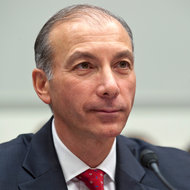LONDON — A “colossal failure” of three top managers was to blame for the collapse of the British mortgage lender HBOS in 2008, a parliamentary review concluded Friday, increasing pressure on regulators to punish individuals who played a role in the demise of their institutions.
The report specifically mentioned Andy Hornby, who was chief executive of the bank until its demise; his predecessor, James Crosby; and the chairman, Dennis Stevenson. The report asked regulators to consider barring them from taking any roles in the financial sector. After the publication of the report, Mr. Crosby stepped down as an adviser to the private equity firm Bridgepoint.
“The HBOS story is one of catastrophic failures of management, governance and regulatory oversight,” Andrew Tyrie, a Conservative member of Parliament and chairman of the review commission, said in a statement.
Leading up to the financial crisis, HBOS was the largest provider of mortgages in Britain, and had expanded aggressively at home but also in Ireland and Australia. But many of the loans were of poor quality and risky and left it with a large exposure to commercial real estate and noninvestment-grade assets.
Losses piled up and HBOS had to be merged into Lloyds Banking Group, which in turn needed a government bailout of more than £20 billion, or about $31 billion at current exchange rates. The government’s holding in Lloyds is worth about £5 billion less than its initial investment.
The review is fanning public anger against bank managers, who oversaw huge losses at companies that became costly for shareholders and taxpayers, but who have remained largely unpunished. Fred Goodwin, the former chief executive of Royal Bank of Scotland, and other executives were sued Thursday by a group of investors over allegations of misleading shareholders before the bank’s collapse.
“Why competence levels on the board were so weak before the financial crisis is still a major question,” said Pete Hahn, a finance professor at the Cass Business School in London. “Maybe there should be a list available worldwide of directors from failed financial institutions.”
The review blamed Mr. Crosby for developing a strategy that supported “reckless lending policies” that left HBOS too exposed to British real estate. Mr. Hornby failed to address the matter when he took over in 2005 and Mr. Stevenson did not raise any concerns as chairman, the report said.
“The combination of higher risk assets and risky funding represents a fundamentally flawed business model and a colossal failure of senior management and of the board,” the 69-page report said.
Britain’s Financial Services Authority “should examine, as part of its forthcoming review of the failure of HBOS, whether these three individuals should be barred from undertaking any role in the financial sector,” the report said.
Peter Cummings, the former head of commercial lending, is the only former HBOS manager sanctioned by the Financial Services Authority. Mr. Cummings is prohibited for life from working in the financial industry again after the regulator found in 2012 that his division was guilty of misconduct. He was also fined £500,000.
The review, which has included numerous interviews with employees and the regulator since October, also criticized the former management for failing to fully understand its role in the lender’s failure.
“We are shocked and surprised that, even after the ship has run aground, so many of those who were on the bridge still seem so keen to congratulate themselves on their collective navigational skills,” the report said. “Lord Stevenson, in particular, has shown himself incapable of facing the realities of what placed the bank in jeopardy from that time until now.”
Article source: http://www.nytimes.com/2013/04/06/business/global/report-urges-lifetime-ban-for-former-hbos-chiefs.html?partner=rss&emc=rss

